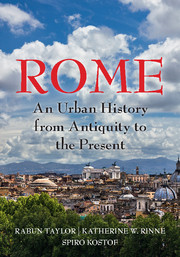Book contents
- Frontmatter
- Dedication
- Epigraph
- Contents
- List of Illustrations
- Acknowledgments
- Map
- INTRODUCTION
- 1 A BEND IN THE RIVER
- 2 A STORYBOOK BEGINNING
- 3 IDEOLOGICAL CROSSFIRE
- 4 BIG MEN ON THE CAMPUS
- 5 RES PUBLICA RESTITUTA
- 6 MEMORIALS IN MOTION: SPECTACLE IN THE CITY
- 7 THE CONCRETE STYLE
- 8 REMAKING ROME'S PUBLIC CORE: I
- 9 REMAKING ROME'S PUBLIC CORE: II
- 10 CRISIS AND CONTINUITY
- 11 RUS IN URBE: A GARDEN CITY
- 12 ADMINISTRATION, INFRASTRUCTURE, AND DISPOSAL OF THE DEAD
- 13 MAPPING, ZONING, AND SEQUESTRATION
- 14 TETRARCHIC AND CONSTANTINIAN ROME
- 15 TROPHIES AND TITULI: CHRISTIAN INFRASTRUCTURE BEFORE CONSTANTINE
- 16 WALLS MAKE CHRISTIANS: FROM FOURTH TO FIFTH CENTURY
- 17 A TALE OF TWO ROMES
- 18 THE ROME OF GOTHS AND BYZANTINES
- 19 CHRISTIAN FOUNDATIONS
- 20 FROM DOMUS LATERANI TO ROMANUM PALATIUM
- 21 THE LEONINE CITY: ST. PETER'S AND THE BORGO
- 22 VIA PAPALIS, THE CHRISTIAN DECUMANUS
- 23 THE URBAN THEATERS OF IMPERIUM AND SPQR
- 24 HOUSING DAILY LIFE
- 25 CHAOS IN THE FORTIFIED CITY
- 26 THE TIBER RIVER
- 27 HUMANIST ROME, ABSOLUTIST ROME (1420–1527)
- 28 PLANNING COUNTER REFORMATION ROME
- 29 PROCESSIONS AND POPULATIONS
- 30 MAGNIFICENT PALACES AND RHETORICAL CHURCHES
- 31 NEOCLASSICAL ROME
- 32 PICTURING ROME
- 33 REVOLUTION AND RISORGIMENTO
- 34 ITALIAN NATIONALISM AND ROMANITÀ
- 35 A CITY TURNED INSIDE OUT
- Glossary of Persons, Places, and Terms
- Works Cited
- Index
30 - MAGNIFICENT PALACES AND RHETORICAL CHURCHES
Published online by Cambridge University Press: 05 July 2016
- Frontmatter
- Dedication
- Epigraph
- Contents
- List of Illustrations
- Acknowledgments
- Map
- INTRODUCTION
- 1 A BEND IN THE RIVER
- 2 A STORYBOOK BEGINNING
- 3 IDEOLOGICAL CROSSFIRE
- 4 BIG MEN ON THE CAMPUS
- 5 RES PUBLICA RESTITUTA
- 6 MEMORIALS IN MOTION: SPECTACLE IN THE CITY
- 7 THE CONCRETE STYLE
- 8 REMAKING ROME'S PUBLIC CORE: I
- 9 REMAKING ROME'S PUBLIC CORE: II
- 10 CRISIS AND CONTINUITY
- 11 RUS IN URBE: A GARDEN CITY
- 12 ADMINISTRATION, INFRASTRUCTURE, AND DISPOSAL OF THE DEAD
- 13 MAPPING, ZONING, AND SEQUESTRATION
- 14 TETRARCHIC AND CONSTANTINIAN ROME
- 15 TROPHIES AND TITULI: CHRISTIAN INFRASTRUCTURE BEFORE CONSTANTINE
- 16 WALLS MAKE CHRISTIANS: FROM FOURTH TO FIFTH CENTURY
- 17 A TALE OF TWO ROMES
- 18 THE ROME OF GOTHS AND BYZANTINES
- 19 CHRISTIAN FOUNDATIONS
- 20 FROM DOMUS LATERANI TO ROMANUM PALATIUM
- 21 THE LEONINE CITY: ST. PETER'S AND THE BORGO
- 22 VIA PAPALIS, THE CHRISTIAN DECUMANUS
- 23 THE URBAN THEATERS OF IMPERIUM AND SPQR
- 24 HOUSING DAILY LIFE
- 25 CHAOS IN THE FORTIFIED CITY
- 26 THE TIBER RIVER
- 27 HUMANIST ROME, ABSOLUTIST ROME (1420–1527)
- 28 PLANNING COUNTER REFORMATION ROME
- 29 PROCESSIONS AND POPULATIONS
- 30 MAGNIFICENT PALACES AND RHETORICAL CHURCHES
- 31 NEOCLASSICAL ROME
- 32 PICTURING ROME
- 33 REVOLUTION AND RISORGIMENTO
- 34 ITALIAN NATIONALISM AND ROMANITÀ
- 35 A CITY TURNED INSIDE OUT
- Glossary of Persons, Places, and Terms
- Works Cited
- Index
Summary
NICHOLAS V'S DECISION TO MOVE THE PAPAL RESIDENCE TO THE VATICAN altered the city's political and cultural landscape. To reflect the new status of the Vatican palace, he enlarged and improved it to serve as his residence, an administrative center for papal business, and a reception space for visiting dignitaries. For defensive reasons he linked it to Castel Sant'Angelo with a wall called the Torrione. His successors further expanded the grounds to include the heights of the Vatican Hill, where Innocent VIII Cibò (1484–1492) later built a small villa, the Belvedere. Julius II linked the palace to the villa with two long wings around a central courtyard designed by Bramante, called the Cortile del Belvedere. Sixtus V divided this in half to house the Sistine Chapel and the Salone Sistina (Fig. 183).
Nicholas V's ministrations to Rome ensured that a citywide surge in palace and church construction would ensue. In fact, the boom lasted 200 years, until the mid-seventeenth century. Colossal palaces such as the Cancelleria and the Palazzo Farnese went up with remarkable speed in the abitato. In the Borgo, too, more important prelates, nobles, and cardinals erected palaces of varying grandeur to be near the center of papal power. For example, Via Alessandrina built by Alexander VI passed alongside one flank of Piazza Scossacavalli, where, with financial inducements to develop the area, two cardinals and a papal chamberlain had all built impressive palaces by about 1520 (Fig. 184). Additionally, Rome's elite undertook to acquire large vineyards and orchards on the intramural hills – but not for their agricultural assets. From the late sixteenth century these productive slopes, favored at last with aqueduct water, were repurposed into luscious villa gardens. The horti of antiquity had returned with a vengeance.
Christendom's most important church was now more than 1,100 years old and probably in physical distress; Nicholas V proposed to demolish it and to build an entirely new basilica. But only in 1505 did Julius II authorize a design competition for a new St. Peter's, which would gradually, after many fits and starts, grow up around its Constantinian ancestor and then, inevitably, consume it.
- Type
- Chapter
- Information
- RomeAn Urban History from Antiquity to the Present, pp. 281 - 291Publisher: Cambridge University PressPrint publication year: 2016



